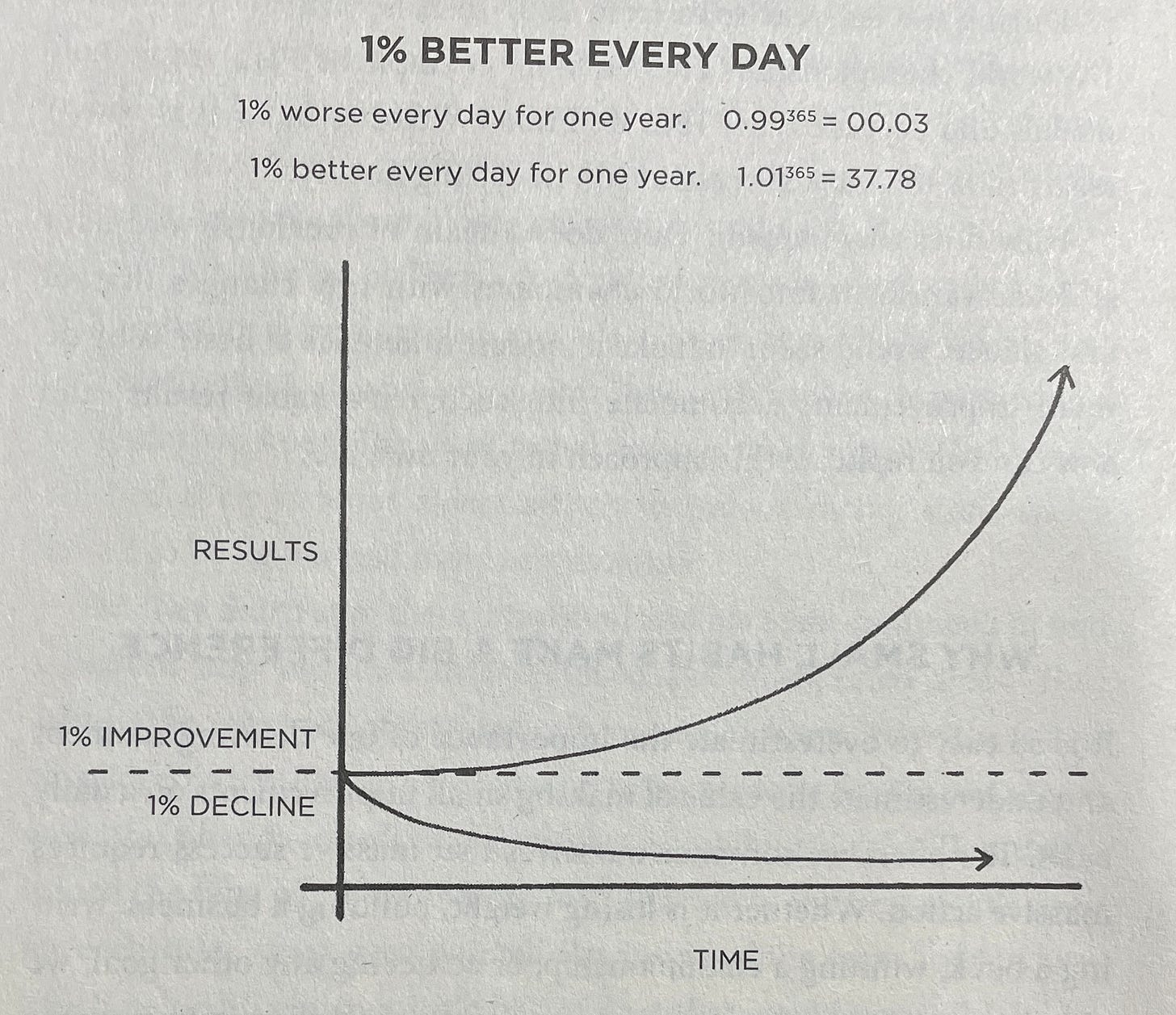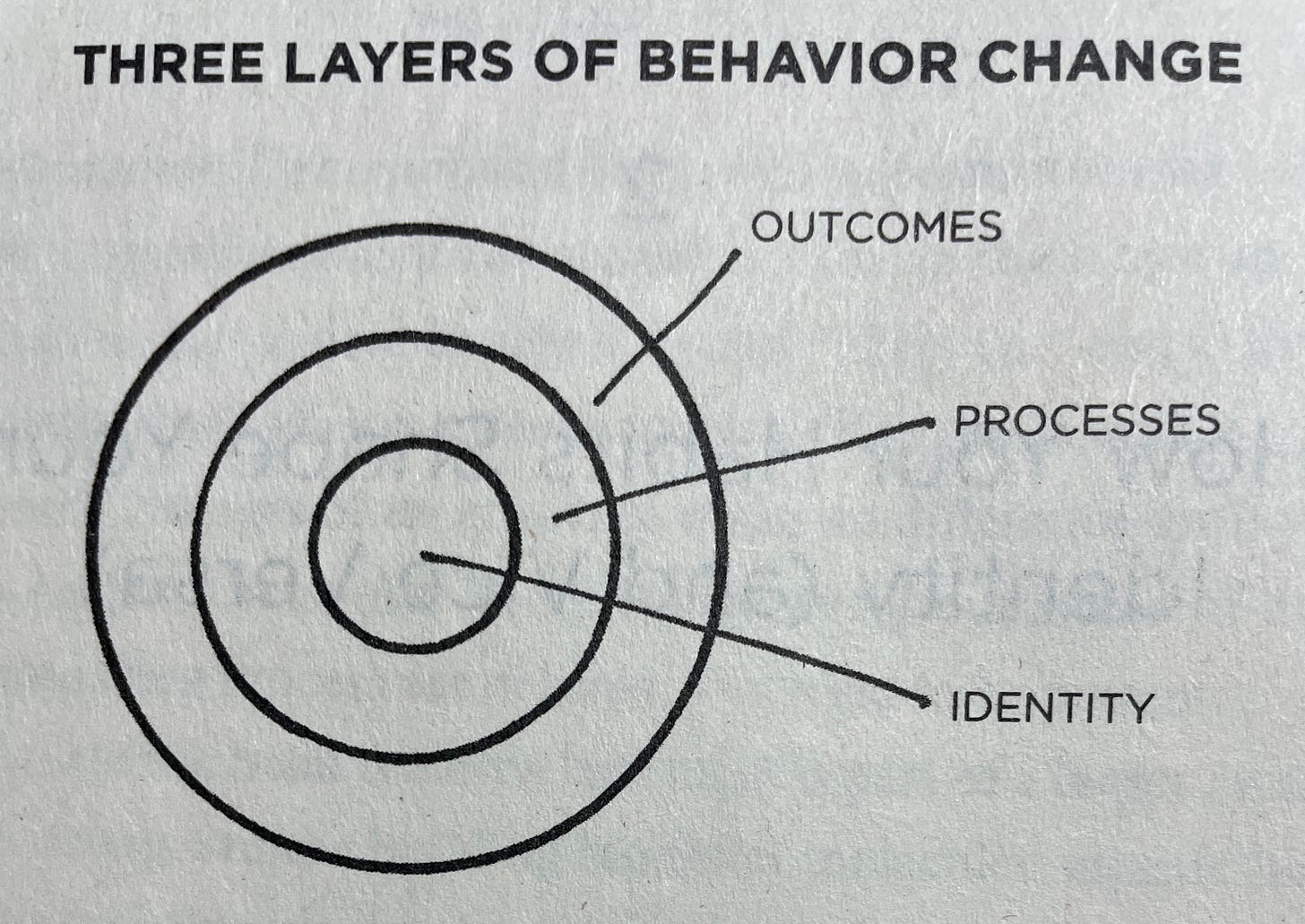Atomic Habits - Tiny Changes, Remarkable Results - Book Club #1
Atomic Habits (by James Clear) is considered to be one of the best books about habit building. James Clear mentions many ways to build good habits and break bad ones. Here, I am discussing the key themes on which the whole books revolves on or the foundation of creating and breaking habits. There are 4 main elements talked in the book:
1% improvement
Focus on systems, not goals
Identity change
4 Laws of behavior change
Why 1% improvement matters
Habits are compound interest of self-improvement. - James Clear
Every decision made, every action done, every mistake made, all compound to our self-improvement. Making ourselves 1% better everyday for a year will make us 38% better at the end of the year. On the contrary, 1% worse everyday for a year make us 0.03% better. We can clearly see that every poor decision, tiny mistake, little excuse or small choice we make, can make us a lot worse. Making ourselves 1% better is a practically possible way to be a better and self-improved person at the end of the year. This graph is from his book:
He also talks about why many people give up on their good habits when they don’t see much improved visual results. The truth is, habits need to be followed for a long time. Few short term small changes can’t give tangible results. Habits need to break that valley of disappointment. This is termed as Plateau of Latent Potential by Clear.
The Importance of systems rather than goals
Goals are about the results you want to achieve. Systems are about the processes that lead to those results.
James points out 4 main problems with setting goals:
Winners and losers have the same goals
Every Olympian wants a gold medal. Every candidate wants the job. Every student want to get better grades. The goal is always there. What it need is to implement a system of continuous small improvements that will help to achieve a different outcome.
Achieving a goal is only a momentary change
Imagine you have a messy room and your goal is to clean it. You will summon the energy to tidy it up. But if you carry on with your messy habits, the room will again get dirty. What you need to do is to change the system on how you use the things in your room. Fix the inputs and outputs will fix themselves.
Goals restrict your happiness
Achieving a goal will give a dopamine release though for a short period of time. Afterwards, you will again want something nice and new. A system first mentality provides the antidote. When you will start to love the process rather than the result, you won’t need the permission of the result to get happy. (To read the document that I wrote about the Secret of Happiness, click here.)
Goals are at odds with long term progress
When you achieve a goal, what will motivate you to do the action again? For example, a runner wants to finish a marathon. He train for months. On the day of the race, when he crosses the finish line, there is no motivation for him to practice running.
The purpose of setting goals is to win the game. The purpose of building systems is to continue playing the game. - James Clear
He advises to work upon building long lasting and effective systems rather than building goals.
Identity change - The North Star of habit change
(Outcomes are what you get. Processes are about what you do. Identity is about what you believe.)
How most of us try to make a habit is by changing the results we get from doing the action, changing the process of performing the action and finally, we become the person who does the action. Refer to this diagram for visual representation:
Clear names it Outcome-Based Habits. How we should be creating habits is by changing our belief, then our process and then focus on outcomes. This way is named as Identity-Based Habits.
For example - Image two person resisting a cigarette. When offered a smoke, the first person says, “No thanks. I’m trying to quit.” It sounds like a reasonable response, but this person still believes he is a smoker who is trying to change while carrying around the same belief. The second person declines by saying, ”No thanks. I’m not a smoker”. It’s a small difference, but this statement signals a shift in identity. Smoking was part of his former life, not their current one. They no longer identify as someone who smokes.
To build identity-based habits, follow these two steps:
Decide the type of person you want to be.
Prove it to yourself with small wins.
I was trying to build a habit of exercising. I did it for a few days and then just abandoned it. After reading this book, I again starting to exercise but this time I told myself that I want to become an athlete. Just this small statement has made me exercise since 1 and a half month.
The 4 Laws of Behavior Change
Further, Clear explains how a habit works. A habit is a loop consisting of 4 parts namely - Cue, Craving, Routine and Reward. Cue triggers your brain to initiate a behavior. Craving is the motivational force behind every habit. Response is the actual habit you perform, which can take the form of a thought or an action. Rewards are the end goal of a habit.
These 4 steps can be divided into 2 phases: the problem phase and the solution phase. The problem phase includes the cue and the craving, and it is when you realize that something needs to change. The solution phase includes the response and the reward, and it is when you take action and achieve the change you desire.
The 4 Laws of habit change provides a simple set of rules for creating good habits and breaking bad ones. Each law acts as a lever which make the habit effortless or impossible.
Make it obvious
We have to consciously make some changes in our environment that will help us make performing the habit more obvious. For me, I have to take medicines for my acne. I have placed my pills in the drawer where I keep my books. After having my meal, when I sit to study I open the drawer to take my books and see the pills. Then, what is left is to just consume them. Placing my medicines in a place which is so obvious helps to perform the habit effortlessly.
Make it attractive
Making a habit more attractive releases dopamine which motivates us to do the action. I love to listen to music as they make me feel that I am living in the moment but I don’t listen to music much as I study for the majority of the day. So, I told myself that I will listen to my favorite tracks while exercising. Listening to music has made exercising more attractive.
Make it easy
Reduce the friction of doing the action by priming the environment. Previously, I wasn’t drinking much water. I realized that drinking water required so much friction for me while I am in deep focus. What I did is, I fill up a bottle of water and put it on my desk. Now, while I am studying I can just open the bottle and drink the water. I would fill up the bottle during my breaks between studying or when I get up to eat a meal.
Make it satisfying
Our brains have developed in such a way that it will prefer to do things that are more satsifying. The Cardinal Rule says,
What is immediately Rewarded is Repeated. What is immediately Punished is Avoided.
I like to have cold showers. For creating my habit of exercising, I told myself that I will have a cold shower if I exercise. I exercise in the evening (from 5:30 to 6:30 or so) and take a chilling and relaxing shower after. Thinking of cold showers make the process of exercising more satisfying.
To create a good habit these are the 4 Laws:
To break a bad habit these are the 4 Laws:
These laws are just framework of habit building or breaking. It is you who have to decide if you want to apply this to your life or not to reap the actual habits.
P.S. - All the images in this document are taken from the the book Atomic Habits. If you are interested to read further, pick a copy of this book for yourself here.











